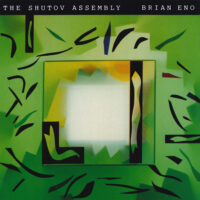
Everybody and their sister rave about Brian Eno’s ’70s and ’80s ambient releases, and rightly so. They influenced many essential chillout specialists and became crucial soundtracks for meditation, deep-tissue massage sessions, and childbirth, among other things. But it would be a grievous mistake to overlook his ’90s output in that genre. :Neroli: from 1993 is another Eno ambient gem that often gets lost in the gush of praise that’s bestowed upon, say, Music For Airports, Ambient 4 (On Land), and the highly overrated Discreet Music. Unquestionably, The Shutov Assembly belongs in any serious discussion about mid-period Eno’s most interesting work.
By the ’90s, Eno was a rich man thanks to his production work for U2, Talking Heads, and James, so he basically could do anything he wanted in the studio and get it released. On The Shutov Assembly, Eno delves into atonality and eschews scales and pitch, which lend the 10 tracks a peculiar liminal quality. Everything sounds unresolved and mysterious. Recorded from 1985 to 1990, these pieces previously appeared in art gallery and museum installations.
“Triennale” opens the album with a paradise of twinkling synths undergirded by serene droning and that enlightening beam of clearlight keening last heard on Tonto’s Expanding Head Band‘s “Riversong.” If you’re not immediately lured into Eno’s enigmatic cathedral of sound, you have some explaining to do. “Alhondiga” presents a fragrant whorl of suspenseful and somewhat sinister drone poems while “Markgraph” offers effortless entry into a strange sonic (sur)reality, in the process creating a new genre: New Age horror.
The alienating and metallic oscillations of “Francisco” make it perhaps the album’s weirdest cut. “Innocenti” renders a gorgeous evocation of stasis; think of it as eternity’s on-hold music. The longest track by far at 16:08, “Ikebukuro” is a languorous depiction of desolation, all long bell tolls, lassoing rope whooshes, and velvety drones.
You may get the sense that this music is “going nowhere.” (I hate this line of thinking. Why do you presume that music must have a destination?) Maybe that’s true from a conventional standpoint, but the suspended-in-mid-air feeling Eno manifests here results in subtly gripping ambient excursions that seemingly emanate from machines, with minimal human input. The Shutov Assembly actually sounds like A.I.-generated music, three decades before the fact. But it’s good—very good.
All Saints finally reissued the album on vinyl in 2014 and again in 2020, so it shouldn’t be too hard to find. I also recommend the CD, a format ideally suited for longform ambient releases. A digital version found on streaming services contains seven bonus tracks. -Buckley Mayfield
Located in Seattle’s Fremont neighborhood, Jive Time is always looking to buy your unwanted records (provided they are in good condition) or offer credit for trade. We also buy record collections.


